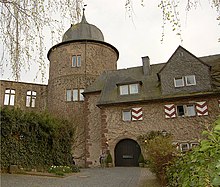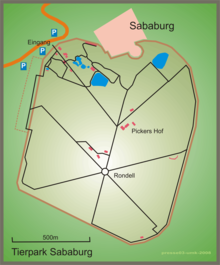Sababurg
| Sababurg (Sleeping Beauty Castle) | |
|---|---|
Zappenburg, Zapfenburg, Dornröschenschloss | |
| Sababurg, town of Hofgeismar | |
 Sababurg and the Reinhardswald from the southwest | |
 Sababurg (Sleeping Beauty Castle) | |
| Coordinates | 51°32′37″N 9°32′15″E / 51.54361°N 9.53750°ECoordinates: 51°32′37″N 9°32′15″E / 51.54361°N 9.53750°E |
| Type | hill castle |
| Code | DE-HE |
| Height | 315 m above sea level (NHN) |
| Site information | |
| Condition | preserved or largely preserved |
| Site history | |
| Built | from 1334 |






The Sababurg, first called the Zappenburg, then Zapfenburg and today, after the Brothers Grimm fairy tale Sleeping Beauty Castle (German: Dornröschenschloss), is the ruin of a hill castle in the legendary Reinhardswald, a forested upland that runs through the North Hessian county of Kassel. Sababurg is also the name of a district of the town of Hofgeismar in which the castle is found.
The hill castle appears in 1334 as the Zappenburg[1] to protect pilgrims to the nearby of . In 1490, the hunting lodge of Zapfenburg grew out of the medieval castle site.[1] After 1957[1] the site was restored and since 1959[1] it has housed an hotel. Together with the Trendelburg and the present ruins belong to the three best known castles in the Reinhardswald region, although the latter is just outside this forest.[2] In the surrounding area is the and the virgin forest of . The concept for the board game, Enchanted Forest, was developed from the castle.
Location[]
The Sababurg stands in the heart of the Reinhardswald in the village of Sababurg in the east-northeast of the Hofgeismar borough of (an estate settlement with a castle). It is located between Beberbeck, about 4.5 km west-southwest of the ruins, and (village east of Trendelburg), around 4.5 km north-northwest (each as the crow flies). The ruins stand on a relatively open basalt kuppe at an elevation of about 315 m above sea level (NHN).[3] Southwest and below the castle is the , through which the little stream of Donnebach, an eastern and right-hand tributary of the Holzape, runs in a northwesterly direction. The ruins, village and wildlife park are an exclave of Hofgeismar, surrounded by the unparished area of Gutsbezirk Reinhardswald, in which the lies on the other side of the park.
History[]
Zappenburg[]
Construction on the Zappenburg (formerly: Zappaborgck and Zappenborgck) began on 19 April 1334[1] to protect and guard pilgrims to the nearby pilgrimage site of , "where in 1330 the uncorrupted body of Jesus is supposed to have been found".[1] It was founded by the Bishopric of Mainz, which was in constant competition with the Landgraviate of Hesse, the Bishopric of Paderborn and the Duchy of Brunswick, whose territories virtually bordered on one another here. The construction was probably funded by income from the pilgrimages. With the completion of the work in 1336 Arnold of became the first castellan or Burgmann.[4]
In 1346 there was a conflict in which Mainz was defeated. The castle was divided between the Landgraviate of Hesse and the Bishopric of Paderborn and, in 1455,[1] described as "abandoned". The castle went entirely into the possession of Hesse in 1462[5] after the end of the Mainz Diocesan Feud.
Zapfenburg and Sababurg[]
In 1490[1] Landgrave William I (1466–1515) "built a fine hunting lodge on the foundation walls of the original site, which was to be a venue for innumerable prestigious festivals and gatherings for 300 years".[1] After this rebuilding or remodelling there was a significant requirement for drinking water for people and animals. This was the catalyst for the construction of a water pipe. In 1508 construction began on the palas, which was finished under his nephew Philip I (1504–1567) in 1519.[5] A stud farm was also laid out.
Today[]
The site of the Sababurg has been gradually restored by the state of Hesse since 1957[1] and opened to the public. From 1959[1] the ruins were converted into a high-class hotel with restaurant and café that was opened in 1960. In addition it houses a theatre, the SabaBurgTheater.[1] In 1987 the first municipal wedding venue in Germany located outside of a town hall was established at the Sababurg. In 2002 a second, larger wedding room was opened.[6]
Of the original defences of the Sababurg, restoration work has uncovered parts of the enceinte with its flanking gate and ditche and bank works. Only the outer walls of the palas have survived. In addition to the two mighty corner towers with their , which are used by the hotel, a small staircase tower has also survived. The chancellery building was expanded in 1976 by a modern extension.
References[]
- ^ Jump up to: a b c d e f g h i j k l Dornröschenschloss Sababurg, at sababurg.de
- ^ „3-Burgen-Tour − Sababurg−Trendelburg−Krukenburg“, auf nordhessen-erleben.de
- ^ Map services of the Federal Agency for Nature Conservation
- ^ Karl Wilhelm Justi, Johann Melchior Hartmann: Hessische Denkwürdigkeiten, Bd. 4, Ausg. 1, Marburg 1805, S. 395–410
- ^ Jump up to: a b Geschichte von Schloss Sababurg, auf burgen-und-schloesser.net
- ^ Heiraten auf dem Dornröschenschloss Sababurg Archived 2015-05-08 at the Wayback Machine, abgerufen am 4. März 2015, auf hofgeismar.de
Literature[]
- Landesamt für Denkmalpflege Hessen (publ.): Denkmaltopographie Bundesrepublik Deutschland. Baudenkmale in Hessen – Kreis Kassel, Teil I. Brunswick, 1988, ISBN 3-528-06239-8
- Eduard Brauns, The Sababurg and der Reinhardswald Geschichte and Gegenwart, 4th edition, 1991
- Rudolf Knappe: Mittelalterliche Burgen in Hessen: 800 Burgen, Burgruinen and Burgstätten. 3rd edition, Wartberg-Verlag, Gudensberg-Gleichen, 2000. ISBN 3-86134-228-6, pp. 18f.
- Hermann-Josef Rapp (ed.): Reinhardswald. Eine Kulturgeschichte. Euregio, Kassel, 2002, ISBN 3-933617-12-X
- Schlösser, Burgen, alte Mauern. Herausgegeben vom Hessendienst der Staatskanzlei, Wiesbaden, 1990, pp. 185f., ISBN 3-89214-017-0
External links[]
| Wikimedia Commons has media related to Sababurg. |
| Wikisource has original text related to this article: |
- Webseite des Hotels Sababurg
- Infoseite Sababurg auf burgenwelt.de
- Vom Burggarten zum Burggärtner − website of the castle gardeners of the Sababurg
- Artist's impression of the Sababurg by Wolfgang Braun
- 1959 establishments in West Germany
- Hill castles
- Renaissance architecture in Germany
- Hotels in Germany
- Castles in Hesse
- Reinhardswald
- Buildings and structures in Kassel (district)

